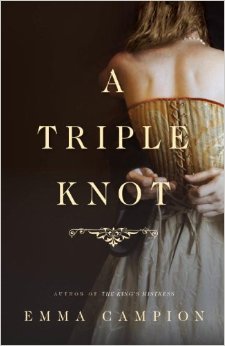A Triple Knot

Summary (from the publisher): The critically acclaimed author of The King's Mistress brings another fascinating woman from history to life in an enthralling story of political intrigue, personal tragedy, and illicit love.
Joan of Kent, renowned beauty and cousin to King Edward III, is destined for a politically strategic marriage. As the king begins a long dynastic struggle to claim the crown of France, plunging England into the Hundred Years’ War, he negotiates her betrothal to a potential ally and heir of a powerful lordship.
But Joan, haunted by nightmares of her father’s execution at the hands of her treacherous royal kin, fears the king’s selection and is not resigned to her fate. She secretly pledges herself to one of the king’s own knights, one who has become a trusted friend and protector. Now she must defend her vow as the king—furious at Joan’s defiance—prepares to marry her off to another man.
In A Triple Knot, Emma Campion brings Joan, the “Fair Maid of Kent” to glorious life, deftly weaving details of King Edward III’s extravagant court into a rich and emotionally resonant tale of intrigue, love, and betrayal.
Joan of Kent, renowned beauty and cousin to King Edward III, is destined for a politically strategic marriage. As the king begins a long dynastic struggle to claim the crown of France, plunging England into the Hundred Years’ War, he negotiates her betrothal to a potential ally and heir of a powerful lordship.
But Joan, haunted by nightmares of her father’s execution at the hands of her treacherous royal kin, fears the king’s selection and is not resigned to her fate. She secretly pledges herself to one of the king’s own knights, one who has become a trusted friend and protector. Now she must defend her vow as the king—furious at Joan’s defiance—prepares to marry her off to another man.
In A Triple Knot, Emma Campion brings Joan, the “Fair Maid of Kent” to glorious life, deftly weaving details of King Edward III’s extravagant court into a rich and emotionally resonant tale of intrigue, love, and betrayal.
Review: I received an uncorrected proof copy of this book as a giveaway on Goodreads.
Joan of Kent is born the cousin to King Edward III, but when her father is executed when Joan is just a young girl, she is left without a father figure to protect her and arrange a marriage. Because of Joan's royal blood, she is seen as a desirable match, but Joan, fearing for her safety and mistrusting the king's schemes for her marriage, secretly marries, and then must fight to be reunited with her true husband for almost a decade. Yet all along, Ned, her cousin and heir to the throne, vows to make Joan his queen, further complicating the royal web in which Joan is ensnared.
Although I have a fairly extensive knowledge of the history of the royal monarchy, this is the first novel I have read that has dealt with this exact period in history, and certainly my first fictional encounter with Joan of Kent. Although the book does provide a listed description of characters, the lack of family tree made it difficult for me to keep up with the royal family's distant relations. Furthermore, the structure of the novel does little to help set the stage. Perhaps the author is assuming a greater knowledge on the part of her reader, in which case I suppose I'm to blame, but I had difficulty following the plot or understanding the political and royal backstory that determine Joan's circumstances. Furthermore, a lot of the characters felt very flat to me, making it difficult for me to really get into the book.
Furthermore, the pacing of the plot felt off to me. Roughly three-fourths of the book are spent with Joan and her true husband Thomas fighting to be reunited. After nearly a decade they finally are. They were married for nearly ten years after being granted permission to live as man and wife, yet this period of their lives, which includes their rise in fortune, Thomas' time at war, the birth of four children, and Joan's eventual remarriage is glossed over in the last 100 pages. I suppose the crux of the novel is the love story between Thomas and Joan, yet I thought there was much more to her life story that could have been a great focal point of the book.
At heart, this novel is a re-imagining of a great love story that ended too soon. Although I was disturbed by Thomas and Joan consummating their marriage when she was just 12 years old, I recognize the reality of the historical period, and I did admire the love between the pair. They seem to never lose faith in the other's love. For example, when Joan's family forces her to marry another, Thomas doesn't question Joan's loyalty, but instead blames his family for not fighting for the match, yelling, "She must have thought I'd deserted her" (222). It's inspiring to think that the couple waited nine and a half years to live together as husband and wife, but finally, victoriously, were able to do so.
Although I was disappointed in many aspects of this novel, I recognize the rich historical possibility of the time, and the author's efforts to bring to life a historical figure that has largely been forgotten.
Stars: 2


Comments
Post a Comment